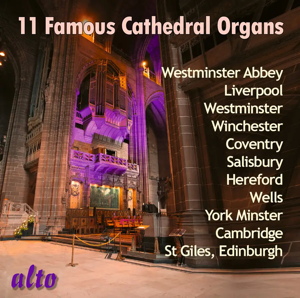
11 Famous Cathedral Organs
rec. 1973-2005
Alto ALC1489 [78]
This is a compilation of thirteen pieces, played on eleven cathedral organs by nine organists, recorded between 1973 and 2005. It is a satisfactory balance of arrangements, originals and warhorses.
First up is Giacomo Meyerbeer’s Coronation March from his opera Le prophète in an unspecified arrangement, perhaps by W T Best. David Hill brings out the celebration and majesty on the Henry Willis III organ at Westminster Cathedral.
I do not think that Herbert Fricker’s arrangement of Sibelius’s pot-boiler Finlandia works well, and not because of Hill or the splendid instrument in Winchester Cathedral. For me, much of the transcription is muddy and growly. On the other hand, Noel Rawsthorne’s performance of Sousa’s Stars and Stripes Forever is a bit of fun. The organ of Coventry Cathedral sounds like a cross between a Wurlitzer and a fairground organ.
I also do not think that Eric Fenby’s transcription of Delius’s Cuckoo in Spring is all right on the organ. I am not sure what the avowed atheist would have thought about his music played by David Halls in Salisbury Cathedral. More appropriate to liturgical practice is William Mathias’s “spiky yet avuncular” Processional performed by Roy Massey at Hereford. Originally written for Modern Organ Music published by OUP, it has retained popularity over the last sixty years. Equally exciting is Theodore Dubois’s vibrant and energetic Toccata in G, first published in Douze Pièces. Francis Jackson gives a sparkling and dexterous performance on York Minster organ.
No organ recital is complete without Bach. Here, Stephen Cleobury gives a thoughtful account of the uplifting Christmas composition In dulci jubilo BWV 608 from the Orgelbüchlein. The organ at Kings College Chapel allows for a good balance between the joyful chorale theme and intricate accompaniment.
Malcolm Archer gives a splendid performance of Louis Vierne’s ever popular Carillon de Longpont from the 24 Pièces en style libre, Book 2 on the organ of Wells Cathedral. It may be of interest that the piece was based on the notes of the four-bell peal in the chapel tower of the Château de Longpont (Aisne).
Next, three works from Liverpool Cathedral played by Noel Rawsthorne. Marc-Antonie Charpentier’s Te Deum Prelude gets an uplifting performance. The track listing does not let on that this is from the Te Deum in D major, H.146. The next number from the ‘Pool is Italian Pietro Yon’s Humoresque ‘L’organo primitivo’ from his collection of Twelve Divertimenti for the organ. It is light-hearted and mimics the sound of an ancient organ with a modern twist. The last work from the ‘World Capital of Pop’ is the Finale of Vierne’s Symphony No.1, his best-known piece. Full of complex figurations and a powerful pedal part, it is a dramatic conclusion to the Symphony. It gets a “bring the house down” performance here.
The mood calms down a bit with Timothy Farrell’s account of Bach’s Jesu Joy of Man’s Desiring, arranged for the organ by the performer. Whether in the Myra Hess piano transcription or as the final movement of the cantata Herz und Mund und Tat und Leben BWV 147 from 1716, the piece never fails to move. The Westminster Abbey organ sounds exquisitely reflective here.
The final work on this compilation is Julius Reubke’s monumentalSonata on the 94th Psalm. Inspired by the biblical text calling for “God’s justice against evil, affirming His omnipotence it offers consolation to the righteous amid hard times.” The three contrasting movements reflect the psalm’s themes of divine vengeance and solace. The century-and-a-half-old work sounds timeless. Along with some of Liszt’s organ music, it is seen as the zenith of Romantic organ literature. Catherine Ennis delivers a powerful and satisfying performance of this technically demanding piece on the organ of St Giles Cathedral, Edinburgh.
I cannot fault the repertoire or the recording but the documentation leaves much to be desired. Absent are the composers’ given names and dates, and the dates of each composition. The liner notes do not mention the music, only briefly discuss the organs, the performers and the venues. There are no recording details. Surely all this information was available to the compilers of this disc. I have added some of this information in my review where possible. To be sure, I did not expect full organ specifications for each venue!
This is a great concept. I hope that more volumes of the excellent organ repertoire will emerge from Alto Records.
John France
Help us financially by purchasing from

Contents
Giacomo Meyerbeer (1791-1864)
Coronation March (1849)
Westminster Cathedral/David Hill
Jean Sibelius (1865-1957)
Finlandia (1899/1907) arr. Herbert Fricker (1868-1943)
Winchester Cathedral/David Hill
John Philip Sousa (1854-1932)
Stars and Stripes Forever (1896)
Coventry Cathedral/Noel Rawsthorne
Frederick Delius (1862-1934)
On Hearing the First Cuckoo in Spring (1912/1934) arr. Eric Fenby (1906-1997)
Salisbury Cathedral/David Halls
William Mathias (1934-92)
Processional (1965)
Hereford Cathedral/Roy Massey
Théodore Dubois (1837-1924)
Toccata in G (1886)
York Minster/Francis Jackson
Johann Sebastian Bach (1685-1750)
In dulci jubilo BWV 608 (c.1708-17)
Kings College Chapel, Cambridge/Stephen Cleobury
Louis Vierne (1870-1937)
Carillon de Longpont from Vingt-quatre pièces en style libre, Book 2 (1913)
Wells Cathedral/Malcolm Archer
Marc-Antoine Charpentier (1643-1704)
Te Deum Prelude (c.1692)
Pietro Yon (1886-1943)
Humoresque (Toccatina for Flutes) (1918)
Louis Vierne
Symphony No.1: Finale (1895-98)
Liverpool Anglican Cathedral/Noel Rawsthorne
Johann Sebastian Bach
Jesu Joy of Man’s Desiring (1716/?) arr. Timothy Farrell
Westminster Abbey/Timothy Farrell
Julius Reubke (1834-1858)
Sonata on the 94th Psalm (1857)
St Giles Cathedral, Edinburgh/Catherine Ennis

















